In-Depth with Mac OS X Lion Server
by Andrew Cunningham on August 2, 2011 8:00 AM ESTA directory isn’t much good to anyone without any objects in it, so we’re going to create a few users and groups to test things out. As with creating a directory, there are a couple of different ways to do it.
In Server.app: Use the plus sign to add new users in the Users section - you can enter their full name, email address, and desired password here, which covers most of the account basics.
Directory accounts (as opposed to accounts local to your server) will appear with a circular blue globe icon next to their names.
Clicking the gear icon will allow you to edit the user’s properties (including the full name, email address, whether he or she can administer the server, and group membership - the user’s short name isn’t changeable after it’s set), as well as edit the services that user can use (making it easy to keep, say, mail or VPN access off-limits to guest users).
Start Workgroup Manager and authenticate using the Directory Administrator privileges you specified when you created your directory. The window you’ll see is a bit scarier than what you get in Server.app.
The four tabs above the left-hand column are for users, user groups, computers, and computer groups - if you made some users or user groups in Server.app before, they’ll show up here, too, and you can enter a lot more info in Workgroup Manager than in Server.app. There’s too much to go into in a general review, but this screenshot will give you an example of the detail you can go into:
The main thing you can do with Workgroup Manager that you can’t do with Server.app is manage OS X preferences - everything from the icons in the Dock to what applications your users are allowed to launch. If you select a user or group or other entry, you can click the Preferences button to see all of your options.
Settings in here are roughly analogous to those in System Preferences in any ol’ Mac.
Workgroup Manager is a powerful tool for managing users and settings, but like many of the other longtime OS X Server standbys, it’s on the road to being deprecated. The preferences managed in Workgroup Manager are mostly to be used for Macs running pre-Lion versions of OS X. Lion (and also iOS) clients are best managed with a tool new to Lion Server: Profile Manager.
Directory accounts (as opposed to accounts local to your server) will appear with a circular blue globe icon next to their names.
Clicking the gear icon will allow you to edit the user’s properties (including the full name, email address, whether he or she can administer the server, and group membership - the user’s short name isn’t changeable after it’s set), as well as edit the services that user can use (making it easy to keep, say, mail or VPN access off-limits to guest users).
Editing a user
Controlling access to services
Under the Groups header, you can create and modify your groups and their memberships. If you’re running the Wiki or iChat services, you can make group-specific wikis and make group members appear automatically on each others’ buddy lists.
The second, more advanced way to edit users and groups is to use Workgroup Manager, another of the Server Admin Tools. Like Server Admin, this used to be the go-to tool for managing not just users and user groups, but also computers and computer groups - managing settings on a computer or computer group basis can be useful if you’ve got web kiosks or computer labs (for instance) that you want to act differently than standard workstations for users who log into them.Start Workgroup Manager and authenticate using the Directory Administrator privileges you specified when you created your directory. The window you’ll see is a bit scarier than what you get in Server.app.
The four tabs above the left-hand column are for users, user groups, computers, and computer groups - if you made some users or user groups in Server.app before, they’ll show up here, too, and you can enter a lot more info in Workgroup Manager than in Server.app. There’s too much to go into in a general review, but this screenshot will give you an example of the detail you can go into:
The main thing you can do with Workgroup Manager that you can’t do with Server.app is manage OS X preferences - everything from the icons in the Dock to what applications your users are allowed to launch. If you select a user or group or other entry, you can click the Preferences button to see all of your options.
Settings in here are roughly analogous to those in System Preferences in any ol’ Mac.
Workgroup Manager is a powerful tool for managing users and settings, but like many of the other longtime OS X Server standbys, it’s on the road to being deprecated. The preferences managed in Workgroup Manager are mostly to be used for Macs running pre-Lion versions of OS X. Lion (and also iOS) clients are best managed with a tool new to Lion Server: Profile Manager.


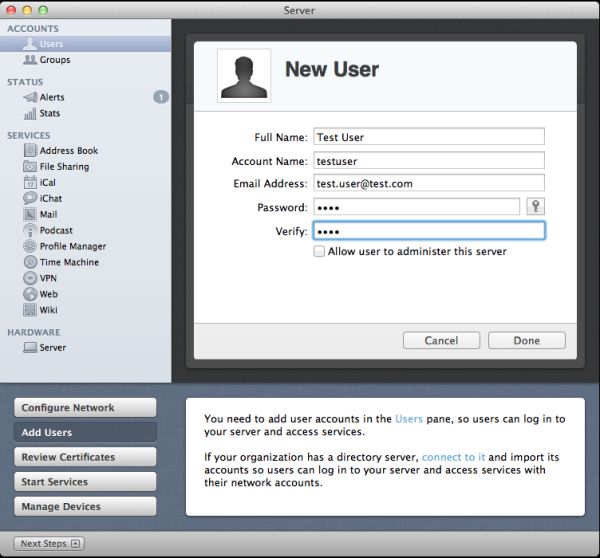
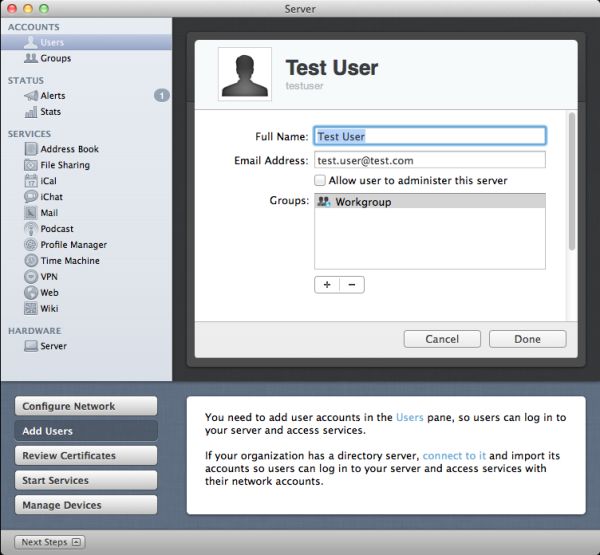
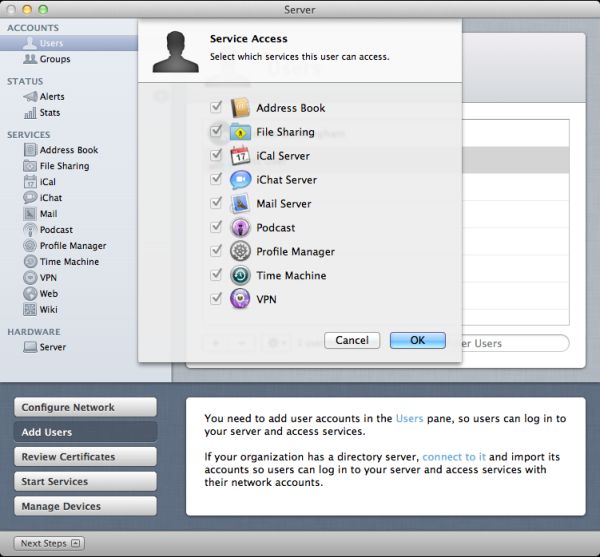
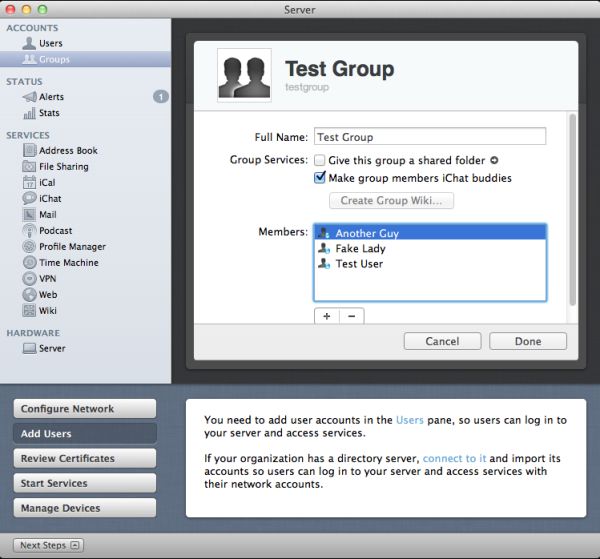
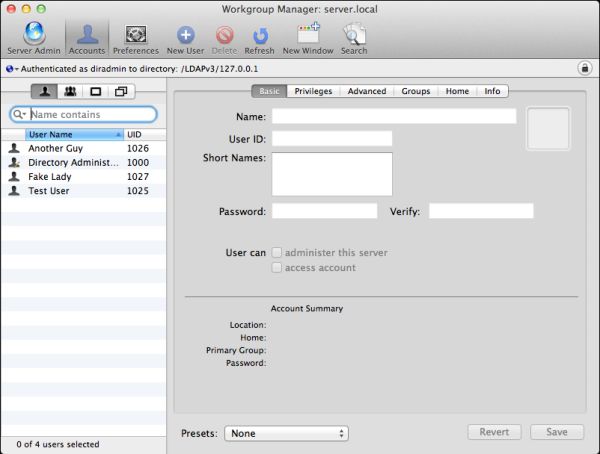
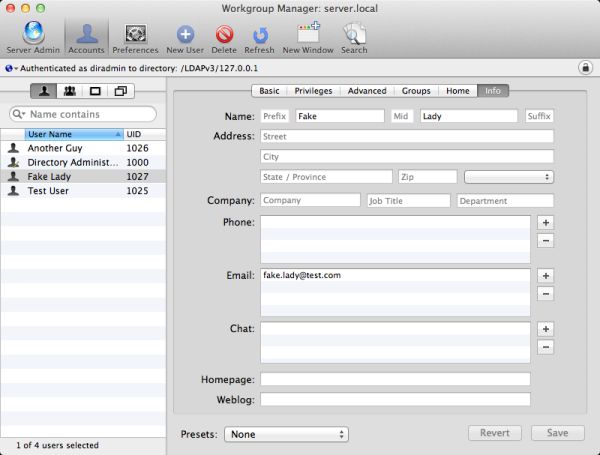
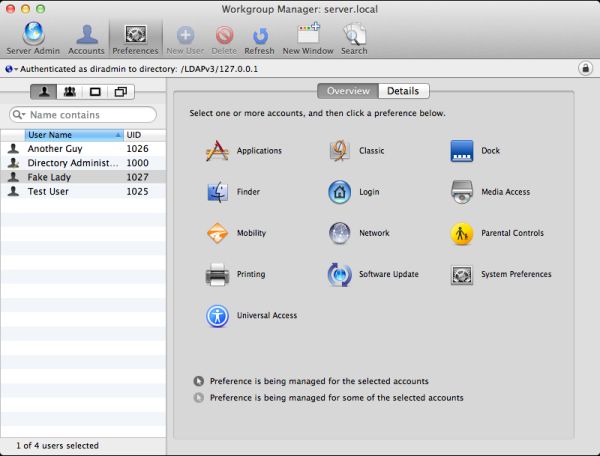








77 Comments
View All Comments
ltcommanderdata - Tuesday, August 2, 2011 - link
Given the shift in corporate policy from being Blackberry focused to adopting other smartphone platforms including iOS, I think most CTOs would take a look at OS X Server if only for the easier iOS device management features. I don't really see it replacing existing Windows servers though, particularly since Apple doesn't sell dedicated server class hardware anymore.quakerotis - Tuesday, August 2, 2011 - link
This is simply not true. OS X Server has been for us a very good performer, both in stability and ease of use. B3an, you must be speaking anecdotally because I am not a fanboy. There are many server technologies to choose from. this is one of the better ones.diskrete - Tuesday, August 2, 2011 - link
As an IT manager for a small company, I would definitely use Lion Server to manage Macs and iPhones.It in no way replaces existing Windows/Linux infrastructure. But recycling a Mac mini to use for managing Apple devices? Absolutely. It’s worth it just for the ability to create machine-based 802.1X profiles.
IT today is not about standardizing on one platform, it’s about using the right tool for the job.
sligett - Thursday, August 4, 2011 - link
Unix isn't a server platform anyone in their right mind would use?There are thousands upon thousands of small and medium businesses as well as schools that are hostage to expensive windows "experts" that have put a Windows server in their business. The client can't do a thing with the server without the expensive help of the expert. You don't see that as a viable market?
So many people speak out on the Internet as though "I can't use this" is equivalent to "no one can use this".
erple2 - Thursday, August 4, 2011 - link
To be fair, any infrastructure that's put in place by an "expert" tends to continue to have to be maintained by another expensive expert. Non-techies have problems with Macs just as much as non-techies have problems with Linux, or Windows machines.BTW, I've found that the mac "experts" that have put a mac server in their business are also very expensive to hire back for help.
There are some very very nice manageability features that OSX Server buys you that aren't all that simple to implement by relative novices in other environments...
cwatt - Monday, September 26, 2011 - link
Ha ha, you are really ignorant! I am currently rolling this out to a big organization and this article is a really big help.. BTW ... those inferior products are actually extremely good quality and very easily managed and a lot more secure than other platforms... You should not let your opinion get in the way of your judgment, you should make the best decision based on the environment not because you are a fanboy or you randomly hate really good products!blueeyesm - Tuesday, August 2, 2011 - link
I have to agree that managing iOS devices using OS X Server is probably their only ace in the hole. The rest of what this offering serves can be replicated/managed better under Linux. That being said, if Apple wanted to be really smart, they'd help their community devise methods in which to enhance a shopping experience, or other interacive experiences with an iOS or tablet device.That is, until cloud computing becomes the de facto standard and Apple ceases to offer a server or client to download, you just are expected to do everything via iTunes/iLife Cloud edition.
badjohny - Tuesday, August 2, 2011 - link
With its drop in price, and ability to install on any mac, I would love to see apple take OSX server and shape it into a WHS for mac. It looks like all or many of those things are available in OSX server, but the ease and convenience of using a WHS is unreal. Push the Home server aspect of OSX server and really make a use for it in a standard home. itunes server edition, Apple TV media server, IOS update manager, Shared home calendars, email, and family based websites come to mind. These are all things that It can currently do, but they all need some "apple magic" to make them very powerful and at the same time very easy for anyone to setup. Apple could easy include a option in the setup of a mac to have it search your network for a server. If it finds one have it ask if you want to enable the features. They could even leverage the icloud system and have it linked by your itunes account. They all the data could sync through the icloud service. enter your apple ID and your client is setup to use your server instantly.They could even make a personal iCloud options. Every picture/video you take have it saved over to the server also.
I understand that OSX server is a niche item in big business. Apple should admit defeat in enterprise setups and push server to a more person level. Have it compete with windows SBS and WHS but make it have the apple easy of use. They have a real product here, but like most home server options it seems to be more of a niche item.
Ratman6161 - Tuesday, August 2, 2011 - link
Basically Apple does not make or sell server grade hardware. Sure, if you look on their online store you will find a version of the Mac Pro that calls itself a server and comes with OSX Server installed. But there are a variety of things about it that make it not enterprise ready and more suited to small business or home servers. If Apple really wanted to be in the enterprise market then what they would absolutely have to do is to allow it to run as a virtual machine on all the major virtualization platforms. For example where I work we are a VMWare shop and no server software is coming in our door that will not run on VMWare Esx server.Its my theory thought hat they have no intention or desire to compete in the enterprise server market. If they did, there would be no reason for a price drop as most businesses in that market place would not have blinked at the $499 price or even the $999 price - both are a drop in the bucket compared to all the other costs associated with a data center. No, the price drop to me definitely signals that its their intent to be in the small business and home server market.
HMTK - Wednesday, August 3, 2011 - link
You're right, Apple does not have anything that could even remotely be called server hardware.There have been rumors that Mac OS can run as a vm on vSphere 5 (if you're ok with the licensing). If true you could run it on real servers and real SANs and use nice features like high availability. The only show stopper is probably licensing but I would think that is VMware were taking the trouble of making OS X run on their hypervisor they would have a deal with Apple.
AFAIC Max OS X Server would be interesting only for managing iOS devices.